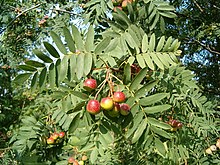An ash can be any of four different tree genera from four very distinct families (see end of page for disambiguation), but originally and most commonly refers to trees of the genus Fraxinus (from Latin "ash tree") in the olive family Oleaceae. The ashes are usually medium to large trees, mostly deciduous though a few subtropical species are evergreen. The leaves are opposite (rarely in whorls of three), and mostly pinnately-compound, simple in a few species. The seeds, popularly known as keys, are a type of fruit known as a samara. The tree's common English name goes back to the Old English æsc, a word also routinely used in Old English documents to refer to spears made of ash wood.







Threats edit
The emerald ash borer Agrilus planipennis, a wood-boring beetle accidentally introduced to North America from eastern Asia with ash wood products circa 1998, has killed millions of trees in southeast Michigan, adjacent Ontario, and some isolated smaller areas on eastern North America. It threatens some 7 billion ash trees in North America. Ash is also used as a food plant by the larvae of some Lepidoptera species - see list of Lepidoptera that feed on ashes.
Uses edit
The wood is hard (a hardwood), tough and very strong but elastic, extensively used for making bows, tool handles, quality wooden baseball bats, hurley sticks and other uses demanding high strength and resilience. It is also often used as material for guitar bodies and snooker cues, known for its bright, cutting tone and sustaining quality. Ash veneers are extensively used in office furniture. It also makes excellent firewood. The two most economically important species for wood production are White Ash in eastern North America, and European Ash in Europe. The Green Ash is widely planted as a street tree in the United States. The inner bark of the Blue Ash has been used as a source for a blue dye. The cortex (bark) of Fraxinus rhynchophylla HANCE (Chinese: Ku li bai la shu), Fraxinus chinensis ROXB. (Chinese: Bai la shu), Fraxinus szaboana English (Chinese: Jian ye bai la shu) and Fraxinus stylosa English (Chinese: su zhu bai la shu)are used in Traditional Chinese Medicine (TCM) for diarrhea, dysenteric disorder, and vaginal discharge. It is also good for the eyes where there is symptoms of redness, swelling, and pain. The dosage is 6-12 grams.
Cultural aspects edit
In Norse mythology, the World Tree Yggdrasil is commonly held to be an ash tree, and the first man, Ask, was formed from an ash tree (the first woman was made from elm or Apple). Elsewhere in Europe, snakes were said to be repelled by ash leaves or a circle drawn by an ash branch. Irish folklore claims that shadows from an ash tree damage crops. In Cheshire, it is said that ash could be used to cure warts or rickets. See also the letter ash.
In Greek mythology, the Meliai were nymphs of the ash, perhaps specifically of the Manna Ash (Fraxinus ornus), as dryads were nymphs of the oak. Many echoes of archaic Hellene rites and myth involve ash trees.
The ash exudes a sugary substance that, it has been suggested, was fermented to create the Norse "Mead of Inspiration."[1]
Other name uses (Green Tree) edit
In North America, the name "Mountain ash" is applied to species of the genus Sorbus, more commonly known in the UK as Rowans and Whitebeams, and the name "Prickly ash" is applied to Zanthoxylum americanum and other Zanthoxylums, all in the family Rutaceae, the rue and citrus family. In Australia, many common eucalyptus species are called ash because they too produce hard, fine-grained timber. The best known of these is the Mountain Ash, the tallest broadleaf tree in the world.
{{Commonscat|Fraxinus}} {{Commonscat|Sorbus}} {{Commonscat|Zanthoxyllum}} {{Commonscat|Eucalyptus regnans}} [[Category:Oleaceae]] [[ang:Æsc]] [[bg:Ясен]] [[ca:Freixe]] [[cs:Jasan]] [[da:Ask-slægten]] [[de:Eschen (Pflanzengattung)]] [[et:Saar (puu)]] [[es:Fraxinus]] [[eo:Frakseno]] [[fr:Frêne]] [[it:Fraxinus]] [[lt:Uosis]] [[no:Asker (plante)]] [[pl:Jesion]] [[pt:Fraxinus]] [[ro:Fraxinus]] [[ru:Ясень]] [[sl:Jesen (drevo)]] [[sr:Јасен]] [[fi:Saarnet]] [[sv:Askar]] [[tr:Dişbudak]]